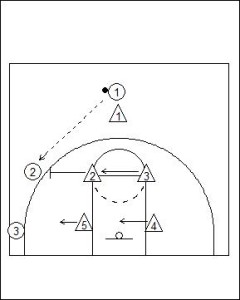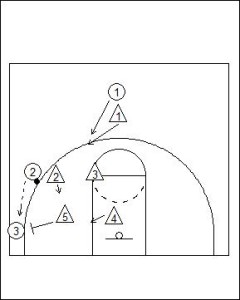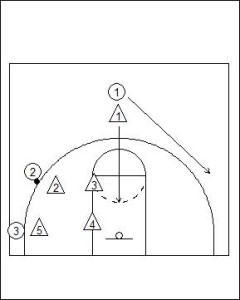Box and 1 Junk Defence
The Box and 1 Junk Defence is one of the more common seen around basketball courts. A junk defence brings together both man-to-man and zone defence principles. A junk defence is most beneficial when there are players of the oppositions who need to have a strict man-to-man denial defence applied for reasons of significant scoring ability or some other offensive quality.
The defensive players involved in the man-to-man match-up can either have help responsibilities or not depending on how significant the match-up is.
Box and 1 Junk Defence works bets if facing an opposition that has one offensive player who needs to be contained. Any more players and some other variations of the junk defence might be more suitable.

The Box and 1 Junk Defence looks to have four players form a zone defence in a “box” formation. One defensive player is then left to guard a player one on one.
The player matching up (One) will pick up their defensive assignment in the half court.
The other four defensive players (Two, Three, Four and Five) form a box around the keyway. Guards will usually be at the top of the box with interior players on the bottom.
As the pass is made to the wing One (1) will still stay in denial and not allow the offensive player to receive a pass back. While One’s (1) player is one pass away this player will always be in full denial.
As the pass is made, the box will shift across towards the ball. The closest defender (Two) moves to guard the ball.
Five (5) will move to the mid-range area crowding the ball handler.
Three (3) will fall in behind the player guarding the ball and deny a post entry pass into the high post. Four will move from the weak side low post to strong side of the split line.

If the offensive player involved in the man-to-man match-up remains on the strong side of the floor then this player will continue to be denied aggressively.
If the ball is passed down the sideline then the closest player (Five) moves to guard the ball.
On the flight of the ball Two (2) will jump of the passer and fill in behind Five (5) again this will provide the illusion of the defence being more condensed and discouraging a dribbling option by the offense.
This movement is suggested as a means of limiting the production of the team’s role players and only providing the option of an easy scoring opportunity through shooting long-range shots. No in the keyway scoring options will be allowed.
The strength in the Box and 1 Junk Defence is in the maintaining of the shape of the “box” so defensive players are always in good help positions.
Again, Four (4) moves across further to the strong side low post.
If needed Three (3) can move down the side of the keyway to help with post targets.
The main aim of the Box and 1 Junk Defence is to have the second, third or lower scoring options for a team’s offense having to make a lot more shots from further way from the basket.

If the offensive player involved in the man-to-man match-up moves across to the weak side of the floor, then the defender can move into a help position.
It is suggested that when the offensive player moves into a position of being two passes away from the ball that a denial position is initiated
The Box and 1 Junk Defence is used to isolate a strong offensive player. Within this reasoning is the commitment to not allowing this player to even receive a pass.
The offensive player will find this a most frustrating situation and in turn limits their ability to contribute to the team’s offensive output.








Leave a Reply